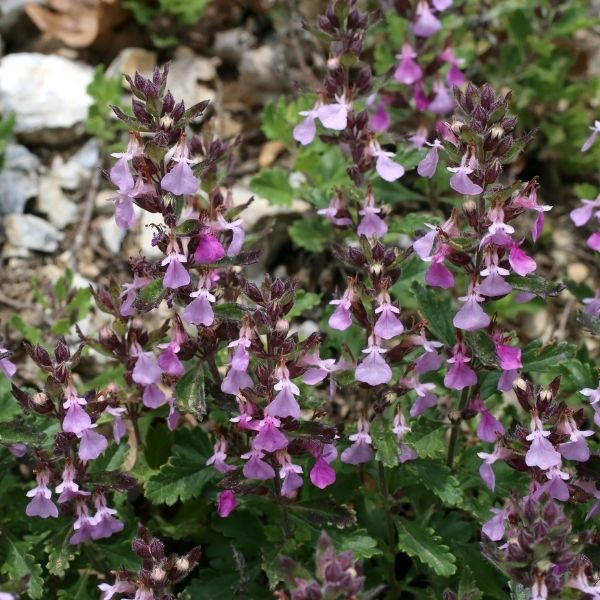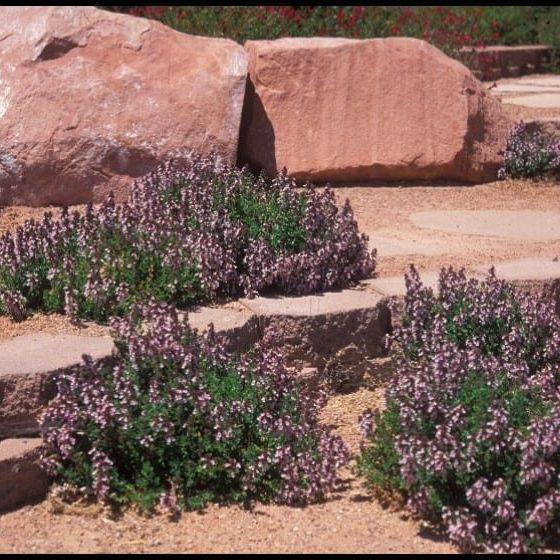

Germander
Teucrium chamaedrys
85 reviews
Germander
Teucrium chamaedrys
85 reviews
1 Gallon
We are sorry, product is currently out of stock due to seasonal availability. Please check the "Related plants available in your area" section below
Not just beautiful - intentionally selected by ShrubHub's 3D landscape design team to fit real-world spaces and maximize yard potential.
Why Germander?
Germander (Teucrium chamaedrys) is a perennial herb that belongs to the mint family. It's native to Europe and has been used traditionally for its medicinal properties. The plant has small, evergreen leaves and produces pink or purple flowers in summer. Germander is commonly grown as a garden plant for its ornamental value, and its leaves are used as a culinary herb. However, caution should be taken as Germander can be toxic if ingested in large amounts.
Sunlight
Germander plants require full sun to partial shade. They thrive in areas with direct sunlight for at least six hours a day. Insufficient sunlight may hinder their growth and lead to leggy or weak plants.
Watering
Germander has moderate watering requirements and prefers moist soil. However, it is important to avoid overwatering, as it can lead to root rot. Proper drainage is necessary to prevent waterlogged soil.
Fertilizing
Germander generally requires a balanced fertilizer with equal amounts of nitrogen, phosphorus, and potassium. However, it is always best to refer to specific soil tests and follow the recommended fertilizer application rates based on the plant's needs.
Enter Germander, a botanical treasure that adds a sense of timeless elegance to your outdoor haven. Let its quiet allure transport you to a garden of yesteryears.
With the addition of this graceful shrub, your garden will exude an effortless air of old-world charm, a touch of grace that harks back to gardens of days gone by. Germander's foliage is a nod to simplicity and refinement, with small, sage-green leaves that form neat, compact mounds. Its appearance evokes a sense of rustic tranquility that brings a touch of nostalgia to your garden.
While Germander's leaves are a study in green, its blooms create a subtle tapestry of color. Imagine tiny flowers that appear like dainty stars, forming a carpet of soft lavender or pink hues. The effect is like a gentle watercolor painting, adding a soft and romantic touch to your garden's canvas.
Germander isn't just a plant – it's an inviting haven for delicate visitors like butterflies and bees. Its nectar-rich blooms become a refuge for these enchanting creatures, turning your garden into a serene gathering place for nature's most graceful inhabitants.
Regardless of your gardening experience, Germander offers an easy path to beauty. It thrives in a variety of conditions, from full sun to partial shade, making it a versatile addition to any garden. With minimal care, you'll enjoy the rewards of its timeless charm.
Add this charming plant to your outdoor space today and let its understated beauty create a haven of tranquility and bring a touch of history to your outdoor sanctuary. Embrace the timeless grace of Germander – because, in the garden of life, simplicity holds its kind of beauty.
Plant Information:
| Botanical Name: | Teucrium chamaedrys |
| USDA Zones: | 5 - 9 |
| Water: | Low Once Established |
| Exposure: | Full Sun |
| Soil Needs: | Well Drained |
| Mature Height: | 8 - 12 inches |
| Mature Spread: | 12 - 18 inches |






Pollination Info
Pollination Information for Germander (Teucrium chamaedrys)
Germander (Teucrium chamaedrys) is a perennial herb that typically blooms from June to September. The plant produces small, pink or purple flowers that are attractive to a variety of pollinators.
Pollinators
Various insects such as bees, butterflies, and moths visit the flowers of Germander to obtain nectar and pollen. The plant is also visited by hummingbirds and other birds that feed on the insects attracted to the flowers.
Pollination Process
The process of pollination in Germander involves the transfer of pollen from the anther of one flower to the stigma of another. The pollinators inadvertently pick up pollen grains on their bodies as they feed on nectar and move from flower to flower. When they visit a new flower, some of the pollen is transferred to the stigma, which fertilizes the ovules and leads to the development of seeds.
Importance of Pollination
Pollination is crucial for the reproduction of Germander and other plants. It leads to the formation of seeds that ensure the continuation of the species. Pollination also plays a vital role in maintaining biodiversity and ensuring the production of crops and other food sources.
Conclusion
Germander is a beautiful and valuable herb that relies on pollinators to ensure its survival and reproduction. By providing a habitat for pollinators and supporting their populations, we can help to ensure the continued existence of Germander and other important plant species.
FAQ
Germander (Teucrium chamaedrys) FAQ
What is Germander?
Germander is a perennial herb that is native to Europe, North Africa, and Asia. It is commonly used in landscaping as a low-growing, evergreen shrub. It produces small purple flowers in the summer months.
What are the growing requirements for Germander?
Germander prefers well-draining soil and full sun to partial shade. It is drought-tolerant and can adapt to a range of soil types. It is also tolerant of most pests and diseases.
How do you propagate Germander?
Germander can be propagated through division or by taking stem cuttings. Division should be done in early spring or fall, while stem cuttings should be taken in late summer or early fall.
What are the medicinal uses of Germander?
Germander has been traditionally used in herbal medicine for its anti-inflammatory, fever-reducing, and diuretic properties. It has also been used for digestive and liver disorders. However, it can be toxic in large quantities and should be used with caution.
Can Germander be used in cooking?
Germander has a bitter taste and is not commonly used in cooking. However, it can be used to flavor liqueurs and as a substitute for hops in brewing beer.
Are there any precautions I should take when using Germander?
Germander should not be used during pregnancy or lactation. It can also interact with certain medications, including blood thinners and medications for high blood pressure. It can be toxic in high doses and should only be used under the guidance of a healthcare professional.
Planting & Care
Planting Germander
Germander prefers well-draining soil in full sun to partial shade. It can be planted in the spring or fall. Before planting, prepare the soil by tilling to a depth of 12 inches and adding organic matter. Dig a hole that is the same depth as the root ball and two times as wide. Place the plant in the hole and backfill with soil. Water thoroughly.
Care for Germander
Water germander deeply once a week during the growing season. It can tolerate drought once established. Fertilize once a month with a balanced fertilizer. Prune in late spring or early summer to control its shape and encourage branching. Pinch back the tips of the stems to stimulate growth. Deadhead spent flowers to encourage additional blooms.
Check Out These Verified Customer Reviews:
Customer Reviews
4.6 out of 5 based on 85 reviews
Thank you! Your review has been submitted.
Beautiful packaging, arrived early
The Germander I ordered arrived in great condition. The quality is top-notch and the website was easy to navigate. Overall, a very positive experience.
The shipment was fast and the Germander was securely packaged to prevent damage.
Item has been added to your cart.


